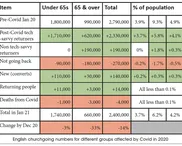Most analyses about church attendance focus on denomination, churchmanship or people’s age. But looking at the environment (catchment area) can also be of significance.
This is helped by the comprehensive March 2021 Government’s Statistical Digest of Rural England, comparing the English rural and urban populations. Those living in rural towns, villages and hamlets are one-sixth, 16%, of the total population, while those living in urban areas (major and minor conurbations, cities and towns) are 83%, the remaining 1% living in what are called ‘sparse settings,’ mostly remote rural areas.
Churchgoing analyses don’t follow the same classifications, which muddies direct comparisons, but those living in commuter rural areas are 10% of all churchgoers, and those in more remote rural areas (which includes sparse areas) are a further 7%, and the total of these two is 17%, the same as the total in the general population. Urban and suburban churchgoers form the remaining 83%.







The unreached 94 per cent
Culture – in the evangelical church, we often talk about this in the context of mission and those of different …